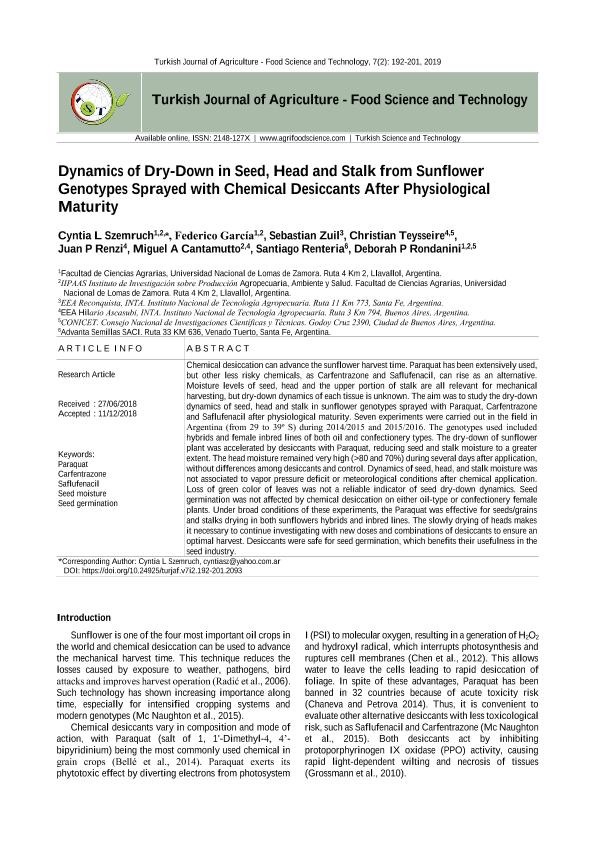Mostrar el registro sencillo del ítem
dc.contributor.author
Szemruch, Cyntia Lorena

dc.contributor.author
Garcia, Federico
dc.contributor.author
Zuil, Sebastian

dc.contributor.author
Teysseire Acevedo, Christian Josue

dc.contributor.author
Renzi, Juan Pablo
dc.contributor.author
Cantamutto, Miguel Ángel

dc.contributor.author
Renteria, Santiago
dc.contributor.author
Rondanini, Deborah Paola

dc.date.available
2020-08-28T18:06:58Z
dc.date.issued
2019-02
dc.identifier.citation
Szemruch, Cyntia Lorena; Garcia, Federico; Zuil, Sebastian; Teysseire Acevedo, Christian Josue; Renzi, Juan Pablo; et al.; Dynamics of dry-down in seed, head and stalk from sunflower genotypes sprayed with chemical desiccants after physiological maturity; Turkish Science and Technology; Turkish Journal of Agriculture - Food Science and Technology; 7; 2; 2-2019; 192-201
dc.identifier.uri
http://hdl.handle.net/11336/112667
dc.description.abstract
Chemical desiccation can advance the sunflower harvest time. Paraquat has been extensively used,but other less risky chemicals, as Carfentrazone and Saflufenacil, can rise as an alternative. Moisture levels of seed, head and the upper portion of stalk are all relevant for mechanical harvesting, but dry-down dynamics of each tissue is unknown. The aim was to study the dry-down dynamics of seed, head and stalk in sunflower genotypes sprayed with Paraquat, Carfentrazone and Saflufenacil after physiological maturity. Seven experiments were carried out in the field in Argentina (from 29 to 39º S) during 2014/2015 and 2015/2016. The genotypes used included hybrids and female inbred lines of both oil and confectionery types. The dry-down of sunflower plant was accelerated by desiccants with Paraquat, reducing seed and stalk moisture to a greater extent. The head moisture remained very high (>80 and 70%) during several days after application, without differences among desiccants and control. Dynamics of seed, head, and stalk moisture was not associated to vapor pressure deficit or meteorological conditions after chemical application. Loss of green color of leaves was not a reliable indicator of seed dry-down dynamics. Seed germination was not affected by chemical desiccation on either oil-type or confectionery female plants. Under broad conditions of these experiments, the Paraquat was effective for seeds/grains and stalks drying in both sunflowers hybrids and inbred lines. The slowly drying of heads makes it necessary to continue investigating with new doses and combinations of desiccants to ensure an optimal harvest. Desiccants were safe for seed germination, which benefits their usefulness in the seed industry.
dc.format
application/pdf
dc.language.iso
eng
dc.publisher
Turkish Science and Technology
dc.rights
info:eu-repo/semantics/openAccess
dc.rights.uri
https://creativecommons.org/licenses/by-nc/2.5/ar/
dc.subject
PARAQUAT
dc.subject
CARFENTRAZONE
dc.subject
SAFLUFENACIL
dc.subject
SEED MOISTURE
dc.subject
SEED GERMINATION
dc.subject.classification
Agricultura

dc.subject.classification
Agricultura, Silvicultura y Pesca

dc.subject.classification
CIENCIAS AGRÍCOLAS

dc.title
Dynamics of dry-down in seed, head and stalk from sunflower genotypes sprayed with chemical desiccants after physiological maturity
dc.type
info:eu-repo/semantics/article
dc.type
info:ar-repo/semantics/artículo
dc.type
info:eu-repo/semantics/publishedVersion
dc.date.updated
2020-07-01T17:15:53Z
dc.identifier.eissn
2148-127X
dc.journal.volume
7
dc.journal.number
2
dc.journal.pagination
192-201
dc.journal.pais
Turquía

dc.journal.ciudad
Sivas
dc.description.fil
Fil: Szemruch, Cyntia Lorena. Universidad Nacional de Lomas de Zamora. Facultad de Ciencias Agrarias. Instituto de Investigación en Producción Agropecuaria Ambiente y Salud. - Comisión de Investigaciones Científicas de la Provincia de Buenos Aires. Instituto de Investigación en Producción Agropecuaria Ambiente y Salud; Argentina
dc.description.fil
Fil: Garcia, Federico. Universidad Nacional de Lomas de Zamora. Facultad de Ciencias Agrarias. Instituto de Investigación en Producción Agropecuaria Ambiente y Salud. - Comisión de Investigaciones Científicas de la Provincia de Buenos Aires. Instituto de Investigación en Producción Agropecuaria Ambiente y Salud; Argentina
dc.description.fil
Fil: Zuil, Sebastian. Instituto Nacional de Tecnología Agropecuaria; Argentina
dc.description.fil
Fil: Teysseire Acevedo, Christian Josue. Instituto Nacional de Tecnología Agropecuaria; Argentina. Consejo Nacional de Investigaciones Científicas y Técnicas; Argentina
dc.description.fil
Fil: Renzi, Juan Pablo. Instituto Nacional de Tecnología Agropecuaria; Argentina
dc.description.fil
Fil: Cantamutto, Miguel Ángel. Instituto Nacional de Tecnología Agropecuaria; Argentina
dc.description.fil
Fil: Renteria, Santiago. Advanta Semillas S.A.I.C.; Argentina
dc.description.fil
Fil: Rondanini, Deborah Paola. Universidad Nacional de Lomas de Zamora. Facultad de Ciencias Agrarias. Instituto de Investigación en Producción Agropecuaria Ambiente y Salud. - Comisión de Investigaciones Científicas de la Provincia de Buenos Aires. Instituto de Investigación en Producción Agropecuaria Ambiente y Salud; Argentina. Consejo Nacional de Investigaciones Científicas y Técnicas. Oficina de Coordinación Administrativa Parque Centenario; Argentina
dc.journal.title
Turkish Journal of Agriculture - Food Science and Technology
dc.relation.alternativeid
info:eu-repo/semantics/altIdentifier/url/http://www.agrifoodscience.com/index.php/TURJAF/article/view/2093
dc.relation.alternativeid
info:eu-repo/semantics/altIdentifier/doi/http://dx.doi.org/10.24925/turjaf.v7i2.192-201.2093
Archivos asociados
